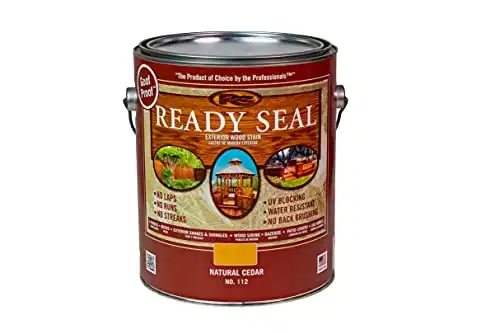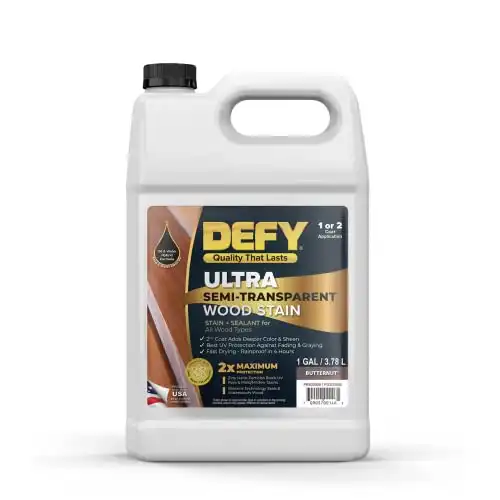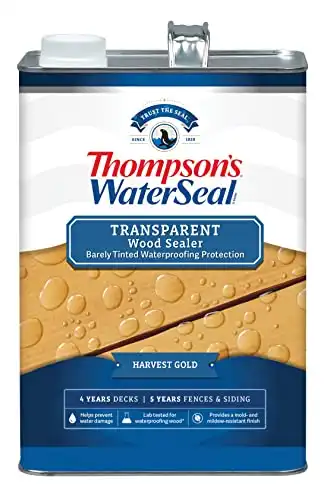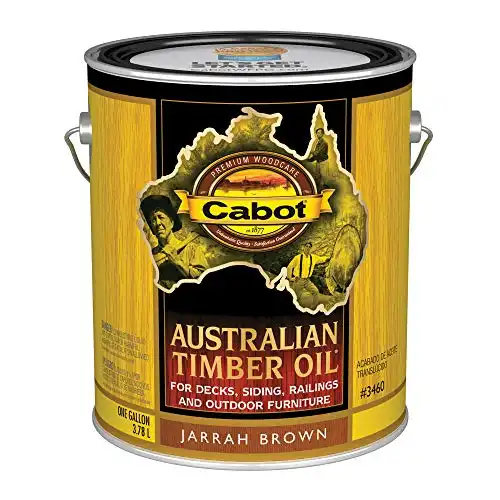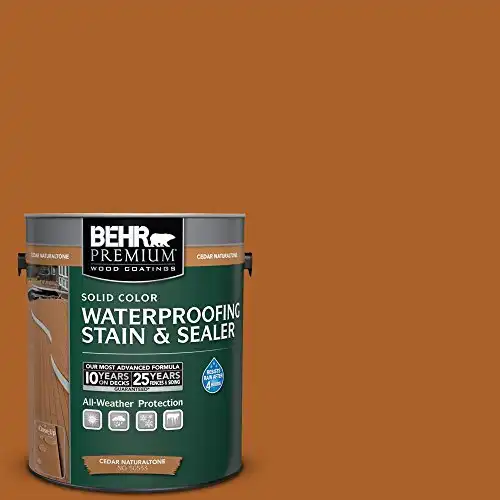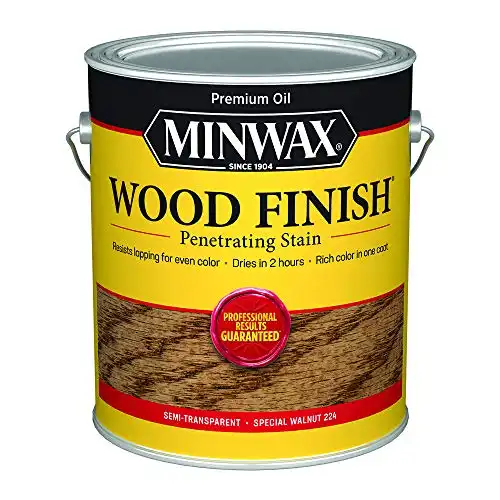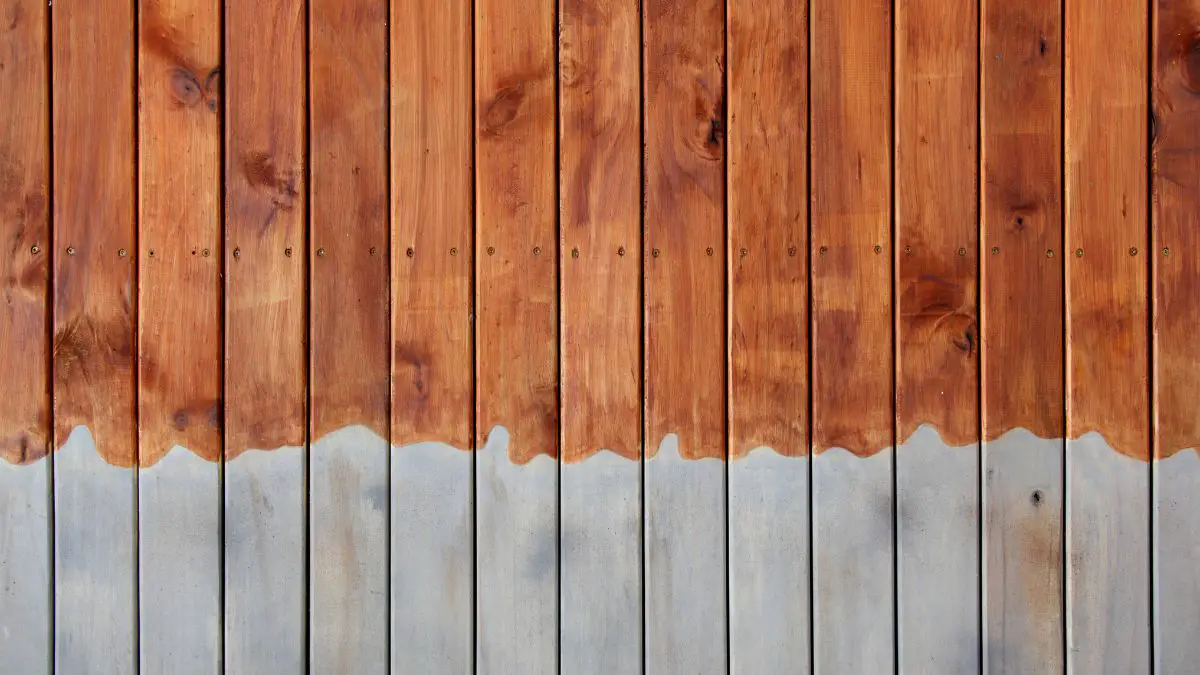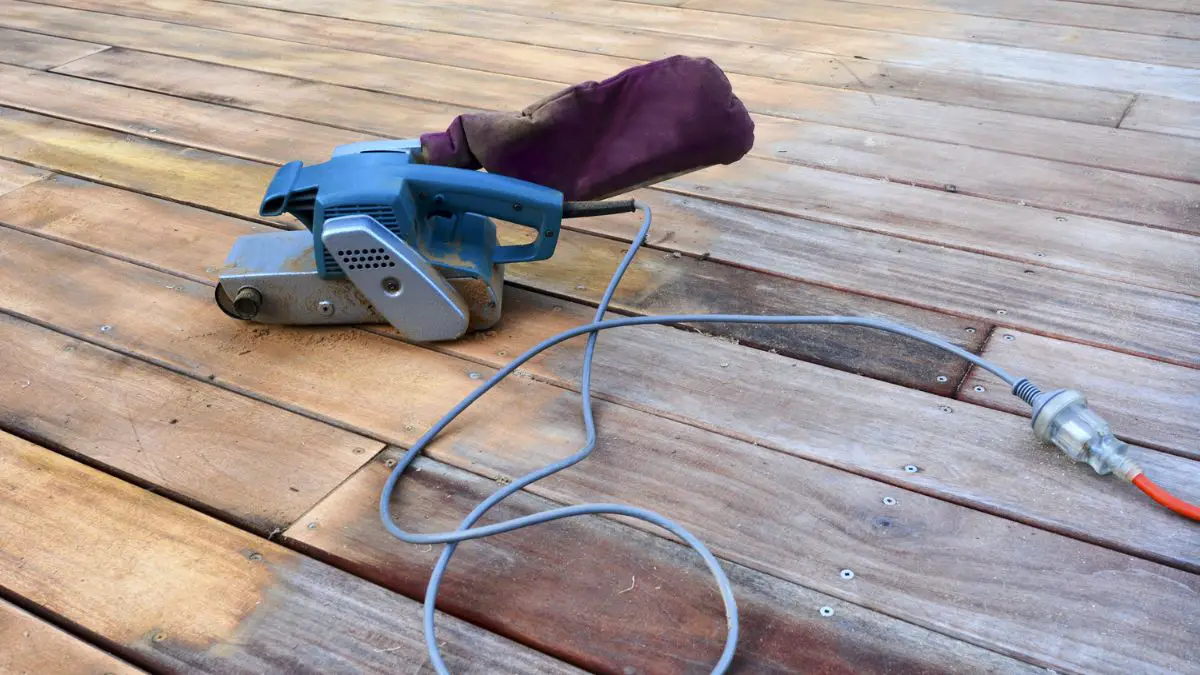You’ve made a great choice with pressure treated wood for your deck. It’s durable, cost-effective, and can withstand the elements. But to truly unlock its potential and prolong its life, staining is a must.
Staining your deck is more than just an aesthetic choice. It’s a strategic move that adds an extra layer of protection to your wood, shielding it from the harsh sun, relentless rain, and even pesky insects. It’s like giving your deck a suit of armor, but instead of steel or iron, you use the best deck stain for pressure treated wood.
Staining your pressure treated deck not only improves its look but also its durability. Top stain choices include Ready Seal Natural Cedar, DEFY Extreme Semi-Transparent, and Thompson’s WaterSeal Transparent, depending on your needs.
We’re diving deep into the world of deck staining. We’ll explore the different types of deck stains, how to choose the right one for your deck, and even share some top stain choices for pressure-treated outdoor wood surfaces.
By the end of this guide, you’ll be equipped with the knowledge and confidence to undertake your deck staining project. So, let’s begin this exciting journey to enhance the beauty and longevity of your exterior surfaces.
| Key Takeaways |
|---|
| Staining your pressure-treated wood deck is crucial for its longevity and aesthetic appeal. |
| There are different types of stain: solid stains, semi-transparent stains, and clear sealers, each with their unique benefits. |
| The best stain for your deck depends on factors like your local climate, the location of your deck, and the condition of your type of wood. |
| Top stain choices include Ready Seal Natural Cedar Exterior Wood Stain and Sealer, DEFY Extreme Semi-Transparent Exterior Wood Stain, and Thompson’s WaterSeal Transparent Waterproofing Stain. |
| Before staining, ensure your deck is clean and dry for the best results. |
| Apply the stain in thin coats and maintain a wet edge to avoid lap marks. |
| Allow ample time for the stain to dry before returning furniture to the deck. |
| Regular maintenance, including cleaning and timely re-staining, can prolong the life and beauty of your stained deck. |
| Address signs of wear and tear promptly to prevent further damage. |
| Always follow the specific instructions provided by the stain manufacturer for the best results. |
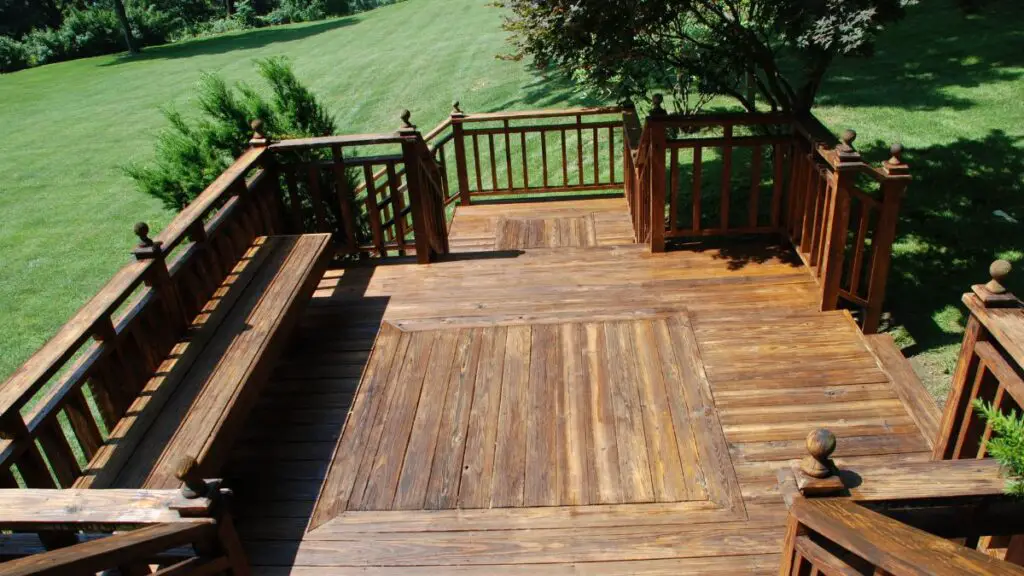
Understanding Pressure Treated Wood
Let’s take a moment to understand what pressure treated wood is. Imagine ordinary wood getting a superpower upgrade. That’s what happens in the pressure treating process. The wood is infused with preservatives to protect it from rot, decay, and destructive insects. It’s a process that significantly enhances the durability and lifespan of the wood, making it a popular choice for outdoor structures.
Now, you might be wondering why is pressure treated wood a top choice for decks. Well, decks are exposed to a lot of wear and tear. They face the harsh elements, endure foot traffic, and often bear the weight of heavy furniture. They need to be made of something tough, something resilient. And that’s where pressure treated wood comes into play.
With its enhanced durability, pressure treated wood can withstand the challenges of being a deck. It resists rot and decay, withstands insect attacks, and can handle changing weather conditions. Whether it’s a scorching summer day or a freezing winter night, your pressure treated wood deck remains standing strong.
So, when planning your deck staining project, remember you’re not just working with any wood type. You’re working with pressure treated wood, a material that’s been engineered for toughness. And with the right deck stain, you can make it even tougher and more resilient.
The Importance of Staining Your Pressure Treated Wood Deck
Staining your pressure treated wood deck isn’t just about enhancing its appearance. It’s about protecting your investment and extending its lifespan. When you apply a high-quality stain, you’re giving your deck a protective shield against the elements.
You’re helping it resist the damaging effects of UV rays, rain, snow, and even foot traffic. It’s like applying sunscreen before a day at the beach or wearing a helmet while biking. It’s about additional protection.
Staining also helps to maintain the integrity of the wood. It prevents moisture from seeping into the wood, which can lead to warping, cracking, and rotting. It’s a crucial step in your deck maintenance routine that can save you from costly repairs or replacements.
On the flip side, not staining your deck can expose it to many problems. Unstained wood is vulnerable to the elements. It can quickly succumb to rot and decay, become discolored due to UV rays, and become a breeding ground for mold and mildew. It’s a risk that can lead to premature aging of your deck and potentially hefty repair bills.
So, when you’re considering whether or not to stain your pressure treated wooden deck, think about the benefits it brings. It’s an investment in the longevity and beauty of your deck, and it’s a step you shouldn’t skip.
Exploring the Types of Stains for Your Deck
When it comes to staining your pressure treated wood deck, you’re not limited to just one type of stain. There are several options available, each with its unique characteristics and benefits. Let’s dive into the three main types: solid stains, semi-transparent stains, and clear wood sealers.
Solid Stains
Think of solid stains as the heavy-duty option in your deck staining arsenal. They offer the highest level of protection and are known for their rich, vibrant colors. Solid stains are opaque, covering the wood grain but highlighting the texture.
They’re a fantastic choice when you want to make a bold statement with your deck or when your deck has seen better days, and you want to cover up imperfections.
Solid stains are like a protective coat of armor for your deck. They shield your wood from UV rays, resist peeling and cracking, and offer high water repellency. They’re the long-lasting deck stain option, often lasting up to five years before needing a reapplication.
Semi-Transparent Stains
Semi-transparent stains are the middle ground between solid stains and clear wood sealers. They offer a good level of extra protection while still allowing some of the wood grain to show through. They’re a popular choice for those who want to enhance the natural beauty of their wooden deck.
Semi-transparent stains penetrate the wood, providing a strong bond that helps prevent peeling and chipping. They’re also excellent at resisting mildew and UV or water damage. While they may not last as long as solid stains, they’re a great choice if you’re looking for a balance between aesthetics and protection.
Clear Sealers
Clear sealers, or transparent stains, are the lightest option. They provide a minimal amount of color, allowing the natural beauty of your wood to take center stage. Clear sealers soak into the wood and provide water resistance, helping to prevent rot and decay.
While clear wood sealers offer the least UV blockers and may require more frequent reapplications, they’re an excellent choice for high-quality wood you want to showcase. They’re also ideal for newer decks that are in good condition.
Choosing the right stain for your deck is crucial in your deck maintenance routine. It’s about finding the balance between protection, aesthetics, and the condition of your wood. Whether you choose a solid stain, a semi-transparent stain, or a clear sealer, remember that the best stain is the one that suits your specific needs and gives your deck the protection it deserves.
Choosing the Right Stain for Your Deck
Selecting the perfect stain for your deck is more than just picking a color you like. It’s about considering various factors that impact the stain’s performance and your deck’s appearance. Let’s explore these factors and guide you in choosing your deck’s best choice.
Consider Your Climate
The climate where you live plays a significant role in your stain choice. If you’re in a region with intense sun, a solid stain with high UV protection can be your deck’s best friend.
A stain with excellent water repellency is crucial for areas with high rainfall or humidity to prevent rot and mildew. A durable stain that can withstand the freeze-thaw cycle is a smart choice in colder climates.
Deck Location Matters
The location of your deck also influences your stain choice. A deck with a lot of shade may benefit from a mildew-resistant stain, while a deck in direct sunlight needs a stain with strong UV protection. Also, consider the traffic your deck gets. High-traffic areas may require a more durable stain to withstand wear and tear.
Matching with Your Exterior Decor
Your deck is an extension of your home, so it must complement your existing exterior decor. Consider the color of your house, outdoor furniture, and landscaping when choosing a stain color. A well-chosen stain can connect these elements and create a harmonious outdoor space.
Test Before You Commit
Before you commit to a stain, it’s a good idea to test it on a small, inconspicuous area of your deck. This will give you a better idea of how the stain will look on your wood and in specific lighting conditions.
Choosing the right stain for your deck is crucial in your deck maintenance routine. It’s not just about aesthetics but also protection and longevity. So, take your time, consider these factors, and choose a stain that will beautify your deck and protect it for years to come.
Top Stain Choices for Pressure Treated Wood
Choosing the right stain for your pressure treated wood deck is crucial for its longevity and aesthetic appeal. With a plethora of options available, it can be challenging to make the right choice. To help you navigate through these options, we’ve compiled a list of top stain choices for pressure treated wood, complete with their pros and cons.
1. Ready Seal Natural Cedar Exterior Wood Stain and Sealer
Ready Seal is a standout choice for its user-friendly nature. This semi-transparent oil-based deck stain and sealer is known for its easy application and natural finish. It seeps deep into the wood, offering protection from within.
Pros
- No primer is required, simplifying the application process.
- It enhances the natural beauty of the wood, making it ideal for those who prefer a more organic look.
- It offers UV protection and water resistance, safeguarding your deck from the elements.
Cons
- It may require more frequent reapplication than solid stains, which could mean more maintenance.
- The color may fade over time, which might not be ideal for those seeking a long-lasting vibrant color.
2. DEFY Extreme Semi-Transparent Exterior Wood Stain
DEFY Extreme is a water-based stain with superior quality resins to resist fading and darkening. This makes it an excellent choice for areas with high sun exposure.
Pros
- It’s environmentally friendly, making it a great choice for the eco-conscious homeowner.
- It offers excellent UV resistance, protecting your deck from the harsh sun.
- It’s easy to maintain and recoat, saving you time and effort in the long run.
Cons
- It may not be as durable as oil-based stains, which could be a drawback for those seeking a long-lasting solution.
- It requires a clean, dry surface for the best results, which means you’ll need to prep your deck thoroughly before application.
3. Thompson’s WaterSeal Transparent Waterproofing Stain
Thompson’s WaterSeal is renowned for its superior waterproofing abilities. If you’re looking to showcase the natural beauty of your wood, this clear sealer is a fantastic choice.
Pros
- It offers excellent water repellency, protecting your deck from moisture damage.
- It’s mildew resistance, keeping your deck looking clean and fresh.
- It’s easy to apply with a sprayer, roller, or brush, offering flexibility in application methods.
Cons
- It offers less UV protection compared to colored stains, which could lead to faster color fading.
- It may require more frequent reapplication, which could mean more maintenance.
4. Cabot Australian Timber Oil Stain
Cabot Australian Timber Oil-Based Stain is a unique blend of oils designed to protect your wood from extreme weather conditions. It’s especially suitable for hardwood decks.
Pros
- It penetrates deep into the wood, offering long-lasting, top-notch protection.
- It enhances the natural color and natural grain of the wood, making it ideal for those who prefer a natural look.
- It’s resistant to chipping and peeling, ensuring your deck looks great for longer.
Cons
- It may darken over time, which might not be ideal for those seeking a lighter color finish.
- It requires careful application to avoid a sticky outdoor woods surface, which could make the application process more challenging.
5. BEHR Premium Solid Color Waterproofing Wood Stain
BEHR Premium is a 100% acrylic formula that seals out the elements and the sun’s harmful UV rays for up to 10 years on decks.
Pros
- It offers a long-lasting natural finish, making it a great choice for those seeking a low-maintenance solution.
- It resists cracking,peeling, and blistering, ensuring your deck stays in top condition for longer.
- It’s available in a wide range of natural colors, giving you the freedom to choose the perfect shade for your deck.
Cons
- It covers the wood grain, which might not be ideal for those who prefer to showcase the natural beauty of their wood.
- It requires careful surface preparation, which could mean more work before you can start staining.
6. Olympic Stain Maximum Wood Stain and Sealer
This stain and sealer from Olympic offer enhanced waterproofing protection and extended life for your deck. It’s a great sealer combo solution that provides a rich, beautiful color and durable finish.
Pros
- It offers advanced sunblock UV defense, protecting your deck from the damaging effects of the sun.
- It’s a stain and sealer combo, saving you time and effort.
- It’s mildew resistant, keeping your deck looking fresh and clean.
Cons
- It may require more than one coat for optimal coverage, which could mean more work.
- It may not adhere well to previously stained surfaces, requiring thorough wooden surface preparation.
7. Minwax Wood Finish Penetrating Stain
Minwax is a trusted name in wood care, and its penetrating stain is a great choice for decks. It penetrates deep into the wood fibers to highlight the grain and texture of the wood.
Pros
- It’s available in a variety of colors, giving you plenty of options to choose from.
- It can be used to add beauty to unfinished wood or to refresh the rich color of previously stained surfaces.
- It’s easy to apply and deeply penetrates the wood for long-lasting protection.
Cons
- It may require a separate sealer for maximum protection, adding an extra step to your project.
- It may not offer as much UV protection as some other options, requiring more frequent reapplication.
Choosing the right stain for your pressure treated wood deck is a crucial decision that can significantly impact its durability and appearance. Consider your specific needs, the climate, and the condition of your deck when choosing. With the right stain, you can enhance the beauty of your deck and enjoy it for many years to come.
How to Apply Stain to Your Deck
Staining your deck is a rewarding project that can significantly enhance the look and longevity of your outdoor space. Here’s a step-by-step guide on how to apply stain to your deck, from preparation to the finishing touches.
Preparation
Before you dive into staining, proper preparation is crucial. Start by clearing your deck of furniture and other items. Next, give your deck a thorough cleaning. Use a deck cleaner to remove dirt, mildew, and old stain.
For stubborn spots, a deck brush can be a handy tool. Once your deck is clean, let it dry completely. This step is critical as applying stain to damp wood can lead to an uneven finish.
Application Process
Now that your deck is clean and dry, it’s time to apply the stain. Start by stirring the stain thoroughly. Don’t shake it; this can create bubbles and an uneven finish.
Apply the stain using a brush, roller, or sprayer, depending on your preference and the product instructions. Work in small sections and maintain a wet edge to avoid lap marks.
It’s better to apply two thin coats than one thick one. This allows the stain to penetrate the wood better and provides a more durable finish.
Drying and Finishing
After applying the stain, give it ample time to dry. The drying time can vary based on the type of stain and the weather conditions, but typically, you should wait at least 24 hours before returning furniture to the deck.
Once the deck is dry, step back and admire your work. The deck should look refreshed and be ready to withstand the elements.
Staining your deck is a project that requires time and patience, but the end result is well worth it. With the right stain and proper application, your pressure treated wood deck can become a beautiful, durable part of your outdoor living space. So, roll up your sleeves and get ready to transform your deck with a fresh coat of stain.
Maintaining Your Stained Deck
Congratulations on staining your deck! Now, let’s talk about how to keep it looking its best. Regular maintenance is key to prolonging the life and beauty of your stained deck.
Regular Cleaning
Dirt, leaves, and other debris can accumulate on your deck over time. Regular cleaning helps prevent this buildup from damaging your stain and the wood underneath. Use a broom to sweep away loose debris and a mild cleaner to tackle dirt and stains. Remember to rinse thoroughly and let your deck dry completely after cleaning.
When to Re-Stain
Even the best solid deck stain won’t last forever. Over time, your stain may start to fade or wear away. This is a sign that it’s time to re-stain.
Solid stains last up to five years, while semi-transparent deck stains and clear sealers may need to be reapplied every two to three years. However, these timelines can vary based on weather conditions and deck usage.
Addressing Wear and Tear
Regular inspections can help you spot and address signs of wear and tear early. Look for peeling or flaking stains, warped or cracked boards, and loose nails or screws. Addressing these issues promptly can prevent further damage and keep your deck looking its best.
Remember, a well-maintained deck is a beautiful deck. With regular cleaning, timely re-staining, and prompt attention to wear and tear, your stained deck can provide a beautiful outdoor space for years.
Related Reading: Tips to Maintain Your Wood Deck
Advantages of Top-Quality Stains for Pressure-Treated Wood
Pressure-treated lumber undergoes toxic chemical treatment to guard against decay and insect damage, allowing for using lower-grade lumber instead of more expensive woods like redwood, cedar, or cypress. This process benefits both consumers and the forestry industry.
However, these lower-grade woods have a more pronounced grain than naturally rot-resistant woods and are more prone to splintering and breaking.
To enhance the longevity of pressure-treated wood, it’s recommended to apply a stain or at least a water repellent as soon as the wood is thoroughly dry. Here are the advantages of treating pressure-treated wood:
Prevent Decay from the Outset
Unsealed wood exposed to the elements will inevitably rot. Rot detracts from the aesthetics of wood projects and compromises their structural integrity. Mildew, termites, and mold contribute to wood rot.
Regrettably, once rot sets in, it’s irreversible. Regularly staining your pressure-treated wood and reapplying coats is crucial to prevent decay. Staining also shields the wood from moisture and sunlight.
Staining is Cost-Effective
Wood is an excellent material for outdoor spaces like decks, but it’s subject to increased wear and tear due to foot traffic. While painting pressure-treated wood is an option, its lack of durability makes it less ideal.
Paint will start to crack and peel in time, diminishing the appearance and exposing the wood to harsh weather conditions. In contrast, a sealant is cheaper to apply and lasts longer before needing maintenance.
Maintain the Wood’s Natural Appeal
The natural grain of wood contributes to its beauty. Staining pressure-treated wood allows the grain to shine through while providing additional protection from the elements.
Stains come in a variety of colors and shades, offering customization options to achieve your desired hue. You can also find uncolored and untinted stains that preserve the wood’s natural appearance.
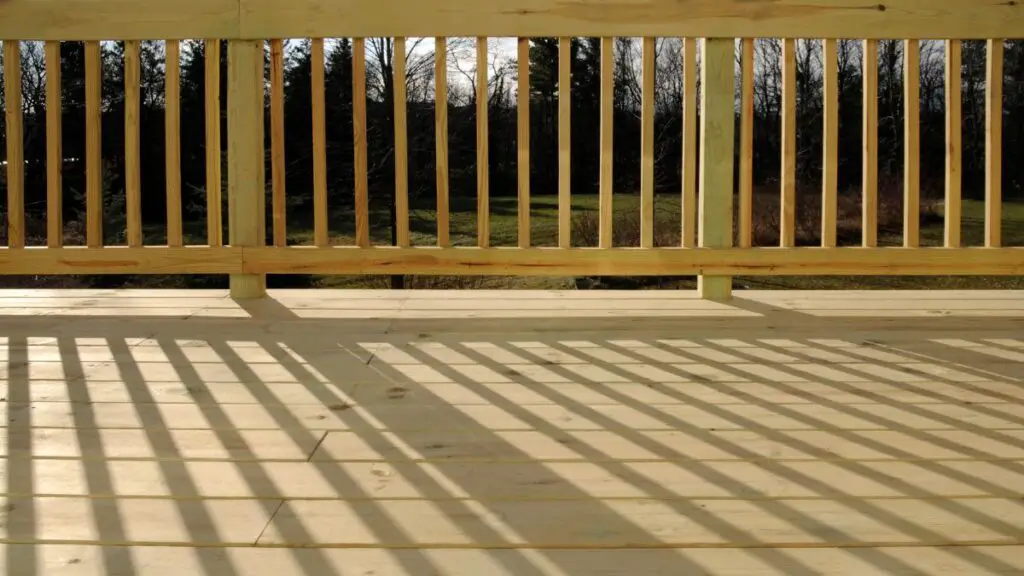
Some Other Things to Look When Buying Stain
Building or restoring a deck is a significant investment in today’s era. Therefore, selecting a deck wood stain that safeguards your investment against aging and weathering is crucial. When choosing the ideal wood deck stain, homeowners and contractors should consider the type of wood deck they’re dealing with, such as pine or cedar, and the desired appearance of the final product.
Types of Deck Stains
Deck stains differ based on their formula, primarily determined by their color composition and the level of transparency or opacity. The base ingredient of the formula, which varies in properties, is also a crucial consideration.
Level of Transparency
The transparency level refers to how clear or opaque a deck stain appears once applied and fully dried. Deck wood stains can range from entirely transparent to fully solid.
- Transparent stains: These are entirely clear stains with no added color, designed to enhance and brighten the natural color, highlight the wood grain, and provide protection. Although truly transparent deck stains should be clear, some marketed as transparent may have a slight tint.
- Semi-transparent stains: These stains have a slight color tint to either introduce a new color to a deck or enhance the original tone. However, these stains still reveal the wood grain and are ideal for new decks requiring a finish.
- Solid stains: Solid stains are completely opaque and pigmented, covering the grain and any imperfections or uneven coloration. They’re perfect for refurbishing an old deck and achieving a bold, consistent color. These stains are thick, offering maximum protection, but their thickness makes them prone to chipping.
- Semi-solid stains: These stains strike a balance between semi-transparent and solid stains. They offer the coverage and high pigment of a solid stain while still revealing some of the grain for a more natural look.
Formula Base
While transparency determines a stain’s finish and color opacity, the formula base deals with protective properties and longevity. We’ll focus on the two traditional and basic types: oil-based and water-based stains.
- Oil-based stains: These stains use various natural oils and penetrate beyond a variety of surfaces to accentuate the wood grain and texture. They absorb into the wood fibers instead of sitting on top, making maintenance easy. However, they’re harder to clean up and can pose potential dangers.
- Water-based stains: These stains create more of a seal and don’t absorb much into the wood, making them durable and long-lasting. They’re environmentally friendly and easy to clean up. However, unlike oil-based stains, water-based ones don’t fade nicely and will chip and peel instead.
Additional Factors
Even products with the same transparency and formula base can vary significantly. The best deck stain often depends on the buyer’s preference and the type of deck. However, it’s important to refer to wood deck stain reviews for an honest look at the stain’s performance.
- Color: The color choice is highly dependent on the buyer’s preference. However, it’s important to remember that the color can change significantly with different levels of transparency.
- Protection: A good stain lasts for years without chipping or peeling, protects the wood deck from damage, and extends its lifespan. Features like UV protection prevent color fading and sun damage, while waterproofing properties prevent moisture absorption to avoid rot and mildew.
- Ease of application: An easy application is important for the user’s convenience and the quality of the finished product. Stains that apply smoothly without streaks are easier to work with and yield a better end result.
FAQs About Best Deck Stain for Pressure Treated Wood
Here are some frequently asked questions about staining pressure treated wood decks:
What is the best stain for a pressure treated deck?
The best stains for pressure treated decks include Ready Seal Natural Cedar Exterior Wood Stain and Sealer, DEFY Extreme Semi-Transparent Exterior Wood Stain, and Thompson’s WaterSeal Transparent Waterproofing Stain.
What type of deck stain lasts the longest?
Solid stains generally last the longest because they provide superior protection against the sun’s UV rays. However, they also hide the wood’s natural grain. Semi-transparent stains don’t last as long but highlight the wood’s natural beauty.
Should you stain a pressure treated wood deck?
Yes, staining a pressure treated wood deck is highly recommended. Staining not only enhances the look of your deck but also provides a protective barrier against the elements. This can help prevent issues like warping, cracking, and rotting, extending the life of your deck.
Remember, these answers are general guidelines. Always follow the specific instructions the stain manufacturer provides for the best results.
Conclusion
You’ve journeyed through the ins and outs of staining your pressure treated wood deck. From understanding the importance of staining, and exploring different types of stains to learning how to apply and maintain them, you’re now equipped with the knowledge to make your larger deck a stunning and durable part of your outdoor living space.
Remember, the best deck stain for pressure treated wood is one that suits your specific needs and preferences. Consider factors like your local climate, the condition of your deck, and your desired look when making your choice. With the right stain and proper care, your deck can be a beautiful, inviting space for years to come. Happy staining!


